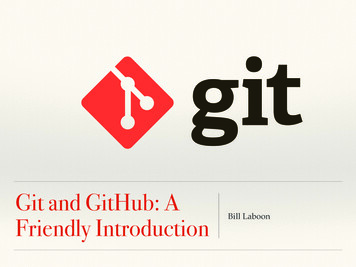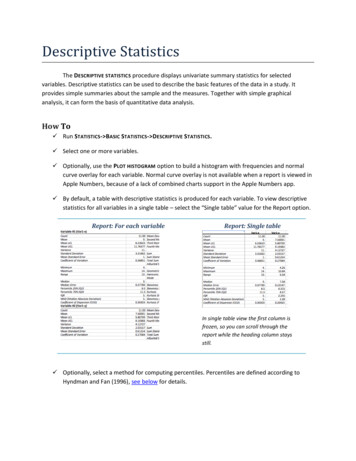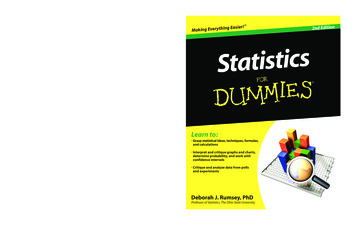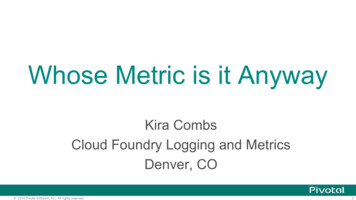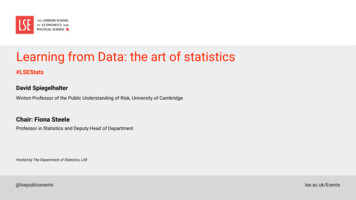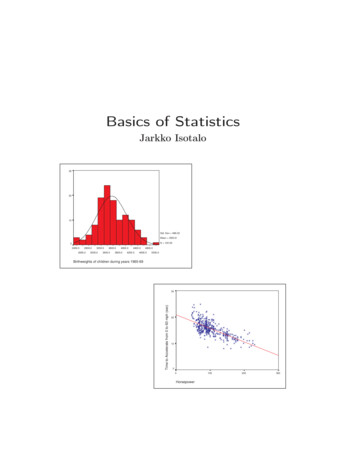
Transcription
Learning Statistics with JASP:A Tutorial for Psychology Students and Other Beginners1(Version ? )2Danielle NavarroUniversity of New South Walesd.navarro@unsw.edu.auDavid FoxcroftOxford Brookes Universitydavid.foxcroft@brookes.ac.ukThomas J. FaulkenberryTarleton State nstatswithjasp.com
OverviewLearning Statistics with JASP covers the contents of an introductory statistics class, as typically taughtto undergraduate psychology students. The book discusses how to get started in JASP as well as givingan introduction to data manipulation. From a statistical perspective, the book discusses descriptivestatistics and graphing first, followed by chapters on probability theory, sampling and estimation, andnull hypothesis testing. After introducing the theory, the book covers the analysis of contingencytables, correlation, t-tests, regression, ANOVA and factor analysis. Bayesian statistics is covered atthe end of the book.CitationNavarro, D.J., Foxcroft, D.R., & Faulkenberry, T.J. (2019). Learning Statistics with JASP: A Tutorialfor Psychology Students and Other Beginners. (Version ?12 ).ii
This book is published under a Creative Commons BY-SA license (CC BY-SA) version 4.0. Thismeans that this book can be reused, remixed, retained, revised and redistributed (includingcommercially) as long as appropriate credit is given to the authors. If you remix, or modify theoriginal version of this open textbook, you must redistribute all versions of this open textbook underthe same license - CC .0/iii
The JASP-specific revisions to the original book by Navarro and Foxcroft were madepossible by a generous grant to Tom Faulkenberry from the Tarleton State UniversityCenter for Instructional Innovation.iv
Table of I34do we learn statistics?On the psychology of statistics . . . . . . . . . .The cautionary tale of Simpson’s paradox . . . .Statistics in psychology . . . . . . . . . . . . . .Statistics in everyday life . . . . . . . . . . . . .There’s more to research methods than statistics.33691111A brief introduction to research design2.1Introduction to psychological measurement . . .2.2Scales of measurement . . . . . . . . . . . . . .2.3Assessing the reliability of a measurement . . . .2.4The “role” of variables: predictors and outcomes2.5Experimental and non-experimental research . . .2.6Assessing the validity of a study . . . . . . . . .2.7Confounds, artefacts and other threats to validity2.8Summary . . . . . . . . . . . . . . . . . . . . . .131317222425273040Describing and displaying data with JASPGetting started with JASP3.1Installing JASP . . . .3.2Analyses . . . . . . . .3.3Loading data in JASP .3.4The spreadsheet . . . .3.5Changing data from one3.6Quitting JASP . . . .3.7Summary . . . . . . . .43. . . . . . . . . . . . . . . . . . . . . . . . . . . . . . . . . . . . . . . . . . . . . . . . . . . . . . . . . . . . . . . . .measurement scale to another. . . . . . . . . . . . . . . . . . . . . . . . . . . . . . . . .Descriptive statistics4.1Measures of central tendency . . . . . . . . . . . . .4.2Measures of variability . . . . . . . . . . . . . . . . .4.3Skew and kurtosis . . . . . . . . . . . . . . . . . . .4.4Descriptive statistics separately for each group . . .v.4546474850525253.5555667376
4.54.65III678Standard scores . . . . . . . . . . . . . . . . . . . . . . . . . . . . . . . . . . . . . 76Summary . . . . . . . . . . . . . . . . . . . . . . . . . . . . . . . . . . . . . . . . . 78Drawing graphs5.1Histograms .5.2Boxplots . .5.3Saving image5.4Summary . . . . . . . . . . . . . . . . . . . . . . . . . .files using JASP . . . . . . . . . . . . . . .Statistical theory838486899091Introduction to probability6.1How are probability and statistics different?6.2What does probability mean? . . . . . . . .6.3Basic probability theory . . . . . . . . . . .6.4The binomial distribution . . . . . . . . . .6.5The normal distribution . . . . . . . . . . .6.6Other useful distributions . . . . . . . . . .6.7Summary . . . . . . . . . . . . . . . . . . .99100101106109113118122Estimating unknown quantities from a sample7.1Samples, populations and sampling . . . .7.2The law of large numbers . . . . . . . . .7.3Sampling distributions and the central limit7.4Estimating population parameters . . . .7.5Estimating a confidence interval . . . . . .7.6Summary . . . . . . . . . . . . . . . . . . . . . . . . . .theorem. . . . . . . . . . . . . . . . . . . . . . . .123123131133139147152Hypothesis testing8.1A menagerie of hypotheses . . . . . . . .8.2Two types of errors . . . . . . . . . . . .8.3Test statistics and sampling distributions8.4Making decisions . . . . . . . . . . . . .8.5The p value of a test . . . . . . . . . . .8.6Reporting the results of a hypothesis test8.7Running the hypothesis test in practice .8.8Effect size, sample size and power . . . .8.9Some issues to consider . . . . . . . . . .8.10 Summary . . . . . . . . . . . . . . . . . .153154157159161164167169170177179vi.
IV9Statistical tools181Categorical data analysis9.1The χ2 (chi-square) goodness-of-fit test . . .9.2The χ2 test of independence (or association)9.3The continuity correction . . . . . . . . . . .9.4Effect size . . . . . . . . . . . . . . . . . . .9.5Assumptions of the test(s) . . . . . . . . . .9.6Summary . . . . . . . . . . . . . . . . . . . .18318319820320320420510 Comparing two means10.1 The one-sample z-test . . . . . . . . . . . . . .10.2 The one-sample t-test . . . . . . . . . . . . .10.3 The independent samples t-test (Student test)10.4 The independent samples t-test (Welch test) .10.5 The paired-samples t-test . . . . . . . . . . .10.6 One sided tests . . . . . . . . . . . . . . . . .10.7 Effect size . . . . . . . . . . . . . . . . . . . .10.8 Checking the normality of a sample . . . . . . .10.9 Testing non-normal data with Wilcoxon tests . .10.10 Summary . . . . . . . . . . . . . . . . . . . . .20720821421922923223723824124624811 Correlation and linear regression11.1 Correlations . . . . . . . . . . . . . . . .11.2 Scatterplots . . . . . . . . . . . . . . . .11.3 What is a linear regression model? . . . .11.4 Estimating a linear regression model . . .11.5 Multiple linear regression . . . . . . . . .11.6 Quantifying the fit of the regression model11.7 Hypothesis tests for regression models . .11.8 Regarding regression coefficients . . . . .11.9 Assumptions of regression . . . . . . . .11.10 Model checking . . . . . . . . . . . . . .11.11 Model selection . . . . . . . . . . . . . .11.12 Summary . . . . . . . . . . . . . . . . . .12 Comparing several means (one-way ANOVA)12.1 An illustrative data set . . . . . . . . .12.2 How ANOVA works . . . . . . . . . . .12.3 Running an ANOVA in JASP . . . . . .12.4 Effect size . . . . . . . . . . . . . . . .12.5 Multiple comparisons and post hoc tests12.6 Assumptions of one-way ANOVA . . . 3295305306307311.
12.712.812.912.1012.11Removing the normality assumption . . . . . . . . . . . . . .Repeated measures one-way ANOVA . . . . . . . . . . . . . .The Friedman non-parametric repeated measures ANOVA testOn the relationship between ANOVA and the Student t-test .Summary . . . . . . . . . . . . . . . . . . . . . . . . . . . . .13 Factorial ANOVA13.1 Factorial ANOVA 1: balanced designs, no interactions . . .13.2 Factorial ANOVA 2: balanced designs, interactions allowed13.3 Effect size . . . . . . . . . . . . . . . . . . . . . . . . . .13.4 Assumption checking . . . . . . . . . . . . . . . . . . . .13.5 Analysis of Covariance (ANCOVA) . . . . . . . . . . . . .13.6 ANOVA as a linear model . . . . . . . . . . . . . . . . . .13.7 Different ways to specify contrasts . . . . . . . . . . . . .13.8 Post hoc tests . . . . . . . . . . . . . . . . . . . . . . . .13.9 The method of planned comparisons . . . . . . . . . . . .13.10 Factorial ANOVA 3: unbalanced designs . . . . . . . . . .13.11 Summary . . . . . . . . . . . . . . . . . . . . . . . . . . 69380Endings, alternatives and prospects14 Bayesian statistics14.1 Probabilistic reasoning by rational14.2 Bayesian hypothesis tests . . . .14.3 Why be a Bayesian? . . . . . . .14.4 Bayesian t-tests . . . . . . . . .14.5 Summary . . . . . . . . . . . . .381agents. . . . . . . . . . . . .38338438939139940115 Epilogue40315.1 The undiscovered statistics . . . . . . . . . . . . . . . . . . . . . . . . . . . . . . . 40315.2 Learning the basics, and learning them in JASP . . . . . . . . . . . . . . . . . . . . 41116 References415viii
?Preface to Version 1{ 2I am happy to introduce “Learning Statistics with JASP”, an adaptation of the excellent “Learningstatistics with jamovi” and “Learning Statistics with R”. This version builds on the wonderful previouswork of Dani Navarro and David Foxcroft, without whose previous efforts a book of this quality wouldnot be possible. I had a simple aim when I begain working on this adaption: I wanted to use theNavarro and Foxcroft text in my own statistics courses, but for reasons I won’t get into right now, Iuse JASP instead of jamovi. Both are wonderful tools, but I have a not-so-slight tendency to preferJASP, possibly because I was using JASP before jamovi split off as a separate project. Nonetheless, Iam happy to help bring this book into the world for JASP users.I am grateful to the Center for Instructional Innovation at Tarleton State University, who gave mea grant to pursue the writing of this open educational resource (OER) in Summer 2019. I am lookingforward to providing my future students (and students everywhere) with a quality statistics text thatis (and forever shall be) 100% free!I invite readers everywhere to find ways to make this text better (including identiying the everpresent typos). Please send me an email if you’d like to contribute (or feel free to go to my Githubpage and just fork it yourself. Go crazy!Thomas J. FaulkenberryJuly 12, 2019Preface to Version 0.70This update from version 0.65 introduces some new analyses. In the ANOVA chapters we have addedsections on repeated measures ANOVA and analysis of covariance (ANCOVA). In a new chapter wehave introduced Factor Analysis and related techniques. Hopefully the style of this new material isconsistent with the rest of the book, though eagle-eyed readers might spot a bit more of an emphasison conceptual and practical explanations, and a bit less algebra. I’m not sure this is a good thing, andmight add the algebra in a bit later. But it reflects both my approach to understanding and teachingstatistics, and also some feedback I have received from students on a course I teach. In line with this,I have also been through the rest of the book and tried to separate out some of the algebra by puttingit into a box or frame. It’s not that this stuff is not important or useful, but for some students theymay wish to skip over it and therefore the boxing of these parts should help some readers.With this version I am very grateful to comments and feedback received from my students andcolleagues, notably Wakefield Morys-Carter, and also to numerous people all over the world who havesent in small suggestions and corrections - much appreciated, and keep them coming! One pretty neatnew feature is that the example data files for the book can now be loaded into jamovi as an add-onmodule - thanks to Jonathon Love for helping with that.David Foxcroftix
February 1st, 2019Preface to Version 0.65In this adaptation of the excellent ‘Learning statistics with R’, by Danielle Navarro, we have replacedthe statistical software used for the analyses and examples with jamovi. Although R is a powerfulstatistical programming language, it is not the first choice for every instructor and student at thebeginning of their statistical learning. Some instructors and students tend to prefer the point-andclick style of software, and that’s where jamovi comes in. jamovi is software that aims to simplifytwo aspects of using R. It offers a point-and-click graphical user interface (GUI), and it also providesfunctions that combine the capabilities of many others, bringing a more SPSS- or SAS-like method ofprogramming to R. Importantly, jamovi will always be free and open - that’s one of its core values because jamovi is made by the scientific community, for the scientific community.With this version I am very grateful for the help of others who have read through drafts andprovided excellent suggestions and corrections, particularly Dr David Emery and Kirsty Walter.David FoxcroftJuly 1st, 2018Preface to Version 0.6The book hasn’t changed much since 2015 when I released Version 0.5 – it’s probably fair to say thatI’ve changed more than it has. I moved from Adelaide to Sydney in 2016 and my teaching profile atUNSW is different to what it was at Adelaide, and I haven’t really had a chance to work on it sincearriving here! It’s a little strange looking back at this actually. A few quick comments. Weirdly, the book consistently misgenders me, but I suppose I have only myself to blame for thatone :-) There’s now a brief footnote on page 12 that mentions this issue; in real life I’ve beenworking through a gender affirmation process for the last two years and mostly go by she/herpronouns. I am, however, just as lazy as I ever was so I haven’t bothered updating the text inthe book. For Version 0.6 I haven’t changed much I’ve made a few minor changes when people havepointed out typos or other errors. In particular it’s worth noting the issue associated with theetaSquared function in the lsr package (which isn’t really being maintained any more) in Section14.4. The function works fine for the simple examples in the book, but there are definitely bugsin there that I haven’t found time to check! So please take care with that one.x
The biggest change really is the licensing! I’ve released it under a Creative Commons licence(CC BY-SA 4.0, specifically), and placed all the source files to the associated GitHub repository,if anyone wants to adapt it.Maybe someone would like to write a version that makes use of the tidyverse. I hear that’s becomerather important to R these days :-)Best,Danielle NavarroPreface to Version 0.5Another year, another update. This time around, the update has focused almost entirely on the theorysections of the book. Chapters 9, 10 and 11 have been rewritten, hopefully for the better. Along thesame lines, Chapter 17 is entirely new, and focuses on Bayesian statistics. I think the changes haveimproved the book a great deal. I’ve always felt uncomfortable about the fact that all the inferentialstatistics in the book are presented from an orthodox perspective, even though I almost always presentBayesian data analyses in my own work. Now that I’ve managed to squeeze Bayesian methods intothe book somewhere, I’m starting to feel better about the book as a whole. I wanted to get a fewother things done in this update, but as usual I’m running into teaching deadlines, so the update hasto go out the way it is!Dan NavarroFebruary 16, 2015Preface to Version 0.4A year has gone by since I wrote the last preface. The book has changed in a few important ways:Chapters 3 and 4 do a better job of documenting some of the time saving features of Rstudio, Chapters12 and 13 now make use of new functions in the lsr package for running chi-square tests and t tests,and the discussion of correlations has been adapted to refer to the new functions in the lsr package.The soft copy of 0.4 now has better internal referencing (i.e., actual hyperlinks between sections),though that was introduced in 0.3.1. There’s a few tweaks here and there, and many typo corrections(thank you to everyone who pointed out typos!), but overall 0.4 isn’t massively different from 0.3.I wish I’d had more time over the last 12 months to add more content. The absence of anydiscussion of repeated measures ANOVA and mixed models more generally really does annoy me. Myxi
excuse for this lack of progress is that my second child was born at the start of 2013, and so I spentmost of last year just trying to keep my head above water. As a consequence, unpaid side projectslike this book got sidelined in favour of things that actually pay my salary! Things are a little calmernow, so with any luck version 0.5 will be a bigger step forward.One thing that has surprised me is the number of downloads the book gets. I finally got some basictracking information from the website a couple of months ago, and (after excluding obvious robots)the book has been averaging about 90 downloads per day. That’s encouraging: there’s at least a fewpeople who find the book useful!Dan NavarroFebruary 4, 2014Preface to Version 0.3There’s a part of me that really doesn’t want to publish this book. It’s not finished.And when I say that, I mean it. The referencing is spotty at best, the chapter summaries arejust lists of section titles, there’s no index, there are no exercises for the reader, the organisation issuboptimal, and the coverage of topics is just not comprehensive enough for my liking. Additionally,there are sections with content that I’m not happy with, figures that really need to be redrawn, andI’ve had almost no time to hunt down inconsistencies, typos, or errors. In other words, this book is notfinished. If I didn’t have a looming teaching deadline and a baby due in a few weeks, I really wouldn’tbe making this available at all.What this means is that if you are an academic looking for teaching materials, a Ph.D. studentlooking to learn R, or just a member of the general public interested in statistics, I would advise youto be cautious. What you’re looking at is a first draft, and it may not serve your purposes. If wewere living in the days when publishing was expensive and the internet wasn’t around, I would neverconsider releasing a book in this form. The thought of someone shelling out 80 for this (which iswhat a commercial publisher told me it would retail for when they offered to distribute it) makes mefeel more than a little uncomfortable. However, it’s the 21st century, so I can post the pdf on mywebsite for free, and I can distribute hard copies via a print-on-demand service for less than half whata textbook publisher would charge. And so my guilt is assuaged, and I’m willing to share! With thatin mind, you can obtain free soft copies and cheap hard copies online, from the following webpages:Soft copy:Hard n so, the warning still stands: what you are looking at is Version 0.3 of a work in progress.If and when it hits Version 1.0, I would be willing to stand behind the work and say, yes, this is atextbook that I would encourage other people to use. At that point, I’ll probably start shamelesslyxii
flogging the thing on the internet and generally acting like a tool. But until that day comes, I’d likeit to be made clear that I’m really ambivalent about the work as it stands.All of the above being said, there is one group of people that I can enthusiastically endorse thisbook to: the psychology students taking our undergraduate research methods classes (DRIP andDRIP:A) in 2013. For you, this book is ideal, because it was written to accompany your stats lectures.If a problem arises due to a shortcoming of these notes, I can and will adapt content on the fly tofix that problem. Effectively, you’ve got a textbook written specifically for your classes, distributedfor free (electronic copy) or at near-cost prices (hard copy). Better yet, the notes have been tested:Version 0.1 of these notes was used in the 2011 class, Version 0.2 was used in the 2012 class, and nowyou’re looking at the new and improved Version 0.3. I’[for a historical summary]m not saying thesenotes are titanium plated awesomeness on a stick – though if you wanted to say so on the studentevaluation forms, then you’re totally welcome to – because they’re not. But I am saying that they’vebeen tried out in previous years and they seem to work okay. Besides, there’s a group of us around totroubleshoot if any problems come up, and you can guarantee that at least one of your lecturers hasread the whole thing cover to cover!Okay, with all that out of the way, I should say something about what the book aims to be. Atits core, it is an introductory statistics textbook pitched primarily at psychology students. As such,it covers the standard topics that you’d expect of such a book: study design, descriptive statistics,the theory of hypothesis testing, t-tests, χ2 tests, ANOVA and regression. However, there are alsoseveral chapters devoted to the R statistical package, including a chapter on data manipulation andanother one on scripts and programming. Moreover, when you look at the content presented in thebook, you’ll notice a lot of topics that are traditionally swept under the carpet when teaching statisticsto psychology students. The Bayesian/frequentist divide is openly disussed in the probability chapter,and the disagreement between Neyman and Fisher about hypothesis testing makes an appearance.The difference between probability and density is discussed. A detailed treatment of Type I, II and IIIsums of squares for unbalanced factorial ANOVA is provided. And if you have a look in the Epilogue,it should be clear that my intention is to add a lot more advanced content.My reasons for pursuing this approach are pretty simple: the students can handle it, and they evenseem to enjoy it. Over the last few years I’ve been pleasantly surprised at just how little difficulty I’vehad in getting undergraduate psych students to learn R. It’s certainly not easy for them, and I’ve foundI need to be a little charitable in setting marking standards, but they do eventually get there. Similarly,they don’t seem to have a lot of problems tolerating ambiguity and complexity in presentation ofstatistical ideas, as long as they are assured that the assessment standards will be set in a fashion thatis appropriate for them. So if the students can handle it, why not teach it? The potential gains arepretty enticing. If they learn R, the students get access to CRAN, which is perhaps the largest andmost comprehensive library of statistical tools in existence. And if they learn about probability theoryin detail, it’s easier for them to switch from orthodox null hypothesis testing to Bayesian methods ifthey want to. Better yet, they learn data analysis skills that they can take to an employer withoutbeing dependent on expensive and proprietary software.Sadly, this book isn’t the silver bullet that makes all this possible. It’s a work in progress, andxiii
maybe when it is finished it will be a useful tool. One among many, I would think. There are a numberof other books that try to provide a basic introduction to statistics using R, and I’m not arrogantenough to believe that mine is better. Still, I rather like the book, and maybe other people will find ituseful, incomplete though it is.Dan NavarroJanuary 13, 2013xiv
Part I.Background-1-
1. Why do we learn statistics?“Thou shalt not answer questionnairesOr quizzes upon World Affairs,Nor with complianceTake any test. Thou shalt not sitWith statisticians nor commitA social science"– W.H. Auden11.1On the psychology of statisticsTo the surprise of many students, statistics is a fairly significant part of a psychological education.To the surprise of no-one, statistics is very rarely the favourite part of one’s psychological education.After all, if you really loved the idea of doing statistics, you’d probably be enrolled in a statistics classright now, not a psychology class. So, not surprisingly, there’s a pretty large proportion of the studentbase that isn’t happy about the fact that psychology has so much statistics in it. In view of this, Ithought that the right place to start might be to answer some of the more common questions thatpeople have about stats.A big part of this issue at hand relates to the very idea of statistics. What is it? What’s it therefor? And why are scientists so bloody obsessed with it? These are all good questions, when you thinkabout it. So let’s start with the last one. As a group, scientists seem to be bizarrely fixated on runningstatistical tests on everything. In fact, we use statistics so often that we sometimes forget to explainto people why we do. It’s a kind of article of faith among scientists – and especially social scientists1The quote comes from Auden’s 1946 poem Under Which Lyre: A Reactionary Tract for the Times, deliveredas part of a commencement address at Harvard University. The history of the poem is kind of interesting: .html-3-
– that your findings can’t be trusted until you’ve done some stats. Undergraduate students might beforgiven for thinking that we’re all completely mad, because no-one takes the time to answer one verysimple question:Why do you do statistics? Why don’t scientists just use common sense?It’s a naive question in some ways, but most good questions are. There’s a lot of good answers to it,2but for my money, the best answer is a really simple one: we don’t trust ourselves enough. We worrythat we’re human, and susceptible to all of the biases, temptations and frailties that humans sufferfrom. Much of statistics is basically a safeguard. Using “common sense” to evaluate evidence meanstrusting gut instincts, relying on verbal arguments and on using the raw power of human reason tocome up with the right answer. Most scientists don’t think this approach is likely to work.In fact, come to think of it, this sounds a lot like a psychological question to me, and since I dowork in a psychology department, it seems like a good idea to dig a little deeper here. Is it reallyplausible to think that this “common sense” approach is very trustworthy? Verbal arguments have tobe constructed in language, and all languages have biases – some things are harder to say than others,and not necessarily because they’re false (e.g., quantum electrodynamics is a good theory, but hardto explain in words). The instincts of our “gut” aren’t designed to solve scientific problems, they’redesigned to handle day to day inferences – and given that biological evolution is slower than culturalchange, we should say that they’re designed to solve the day to day problems for a different world thanthe one we live in. Most fundamentally, reasoning sensibly requires people to engage in “induction”,making wise guesses and going beyond the immediate evidence of the senses to make generalisationsabout the world. If you think that you can do that without being influenced by various distractors,well, I have a bridge in London I’d like to sell you. Heck, as the next section shows, we can’t even solve“deductive” problems (ones where no guessing is required) without being influenced by our pre-existingbiases.1.1.1The curse of belief biasPeople are mostly pretty smart. We’re certainly smarter than the other species that we sharethe planet with (though many people might disagree). Our minds are quite amazing things, and weseem to be capable of the most incredible feats of thought and reason. That doesn’t make us perfectthough. And among the many things that psychologists have shown over the years is that we reallydo find it hard to be neutral, to evaluate evidence impartially and without being swayed by pre-existingbiases. A good example of this is the belief bias effect in logical reasoning: if you ask people todecide whether a particular argument is logically valid (i.e., conclusion would be true if the premiseswere true), we tend to be influenced by the believability of the conclusion, even when we shouldn’t.For instanc
A Tutorial for Psychology Students and Other Beginners (Version 1? 2) DanielleNavarro UniversityofNewSouthWales d.navarro@unsw.edu.au . I am happy to introduce “Learning Statistics with JASP”, an adaptation of the excellent “Learning . feel more than a little uncomfortable. However, it’s the 21st

